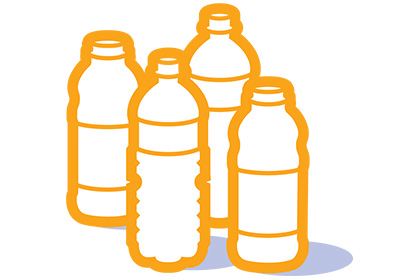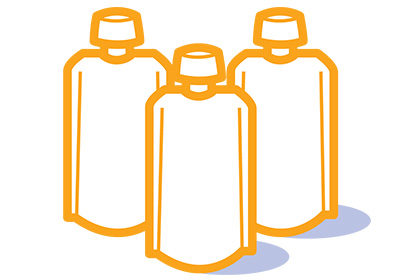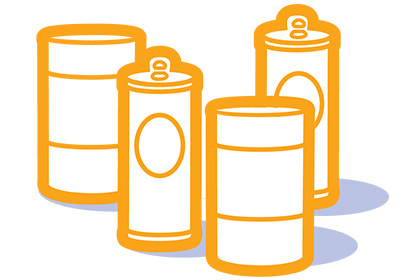5 Environmental Impact
- Detailed report on the reduction in greenhouse gas emissions, energy savings, and C02 equivalent reduced from recycling.
- End Fate report for aluminum, plastic, glass, polycoat and other materials.
5.1 Environmental Report
The Government of British Columbia has adopted public policies intended to promote a low carbon economy. As a stewardship agency operating under a provincial regulation, Encorp compiles applicable data, analyzes and reports on the impacts of its stewardship activities.
In 2019, Encorp recycled 93,763 metric tonnes of used beverage containers. The energy saved through the recycling of these materials has been converted into tonnes of carbon dioxide equivalent (CO2e) the common measure of greenhouse gases (GHGs), based on the US Environmental Protection Agency’s Waste Reduction Model (WARM). The avoided emissions published in this report were calculated using the WARM version 13 [06/14] (Refer to End Fate table in Section 5.2).
In total, Encorp’s activities in 2019 contributed to the reduction of about 104.8 thousand tonnes of CO2 equivalent being released into the atmosphere, compared to 102.6 thousand tonnes in 2018. The higher CO2 reduction is primarily attributed to the increase in the volume of aluminum containers that contributes to higher emission savings by recycling.
While recycling has an overall net benefit in terms of energy and emissions savings, the recycling process itself requires energy and thus has GHG emissions associated with it. When estimating net savings Encorp calculates the GHG emissions specifically associated with its stewardship activities.
Since Encorp is not a manufacturing company, the majority of our associated GHG emissions come as a result of transporting materials as well as heating and powering our network of facilities.
Therefore, we define Encorp’s GHG inventory boundary from the point that empty containers enter into the Encorp system at either a depot or retailer, right through to when the materials are delivered to the end processors for recycling into new products.
Greenhouse gas emissions (GHGs) are estimated using conversion factors and methodologies developed by the World Resource Institute’s Greenhouse Gas Protocol {WRIGGP}. The collection, transportation and processing services provided to Encorp are done through third party independent contractors and the emissions produced by these activities are classified as Indirect Scope 3 GHG emissions in accordance with the WRIGGP. As there is limited data available for Scope 3 emissions, we accept that our information may not be as complete.
Emission calculations from electricity purchased were based on data gathered from a number of depots and processors in each region of the province. Results were used to estimate the energy use per metric tonne of material collected, then extrapolated to the total weight of used beverage containers collected in the province.
The estimated energy consumption in Kw Hs was then converted into the carbon dioxide emissions using the calculators offered by the WRIGGP. For estimated emissions inventory refer to the table below.
We report the reduction in emissions from all sources further to the change in the mix of material collected and, therefore, end markets.
Emissions Inventory Summary
| Type of Emission | 2019 | 2018 |
|---|---|---|
| (tonnes CO2) | ||
| Direct emissions are emissions from sources that are owned or controlled by Encorp | ||
| Employee travel – gas use | 6 | 9 |
| Indirect emissions occur as a consequence of Encorp’s activities, but are from sources not owned or controlled by Encorp. Included are emissions from purchased electricity consumed by Encorp’s offices, depots, processors and transporters[i]. | ||
| Offices (excluding head office) | ||
| Purchased electricity / Gas in leased buildings | 5 | 4 |
| Employee domestic air travel / ferry travel | 10 | 12 |
| Depots - all purchased electricity / gas consumed in owned or leased buildings | 228 | 237 |
| Processors - all purchased electricity / gas consumed in owned or leased buildings | 57 | 60 |
| Transportation – depots to processors (diesel fuel) | 3,596 | 3,600 |
| Transportation – processors to end markets (diesel fuel) | 1,924 | 2,358 |
| Sea Cargo (based on metric tonne km) | 2,407 | 2,682 |
| Total Emissions from all sources | 8,233 | 8,962 |
[i] All indirect emissions except for office use were calculated based on the sample data provided by selected depots, processors, and transporters.

5.2 Container Recycling End Fate Report
All containers collected by Encorp in 2019 were shipped to recyclers for further processing into new material in accordance with Section 8 of the Recycling Regulation.







